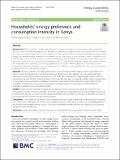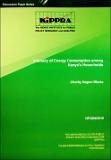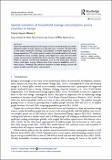Households' Energy Preference and Consumption Intensity in Kenya
| dc.date.accessioned | 2020-12-09T10:33:37Z | |
| dc.date.available | 2020-12-09T10:33:37Z | |
| dc.date.issued | 2019 | |
| dc.identifier.uri | http://repository.kippra.or.ke/handle/123456789/2359 | |
| dc.description.abstract | There have been notable joint efforts from the private and public sectors in promoting households’ access to clean and efficient energy sources. Despite the noteworthy progress realized over the years, the consumption and reliance on clean energy sources are reportedly low. This scenario is evident among households practicing multiple energy use, whereby energy proportions consumed from the clean energy sources are much lower compared to nonclean energy sources. As such, reliance on non-clean energy has greatly hindered the projected welfare and productive gains that comes along with access to clean energy sources. To understand households’ energy consumption behavior, this study takes into consideration that energy preference (choice) and intensity (proportions consumed) are two independent decisions. Therefore, a succinct understanding of the factors affecting these decisions acts as a basis for an optimal transition to clean energy sources... | en |
| dc.language.iso | en | en |
| dc.publisher | BioMed Central Ltd | en |
| dc.relation.ispartofseries | Journal Article;2019 | |
| dc.subject | Energy Consumption | en |
| dc.subject | Clean energy sources | en |
| dc.subject | Energy Preference | en |
| dc.subject | Consumption Intensity | en |
| dc.subject | Double-hurdle | en |
| dc.title | Households' Energy Preference and Consumption Intensity in Kenya | en |
| dc.type | Journal Article | en |
| ppr.contributor.author | Kisaka, Oscar Masika | |
| ppr.contributor.author | Gikonyo, Joseph | |
| ppr.contributor.author | Mbaka, Charity Kageni |
Files in this item
This item appears in the following Collection(s)
-
Journal Articles [31]



